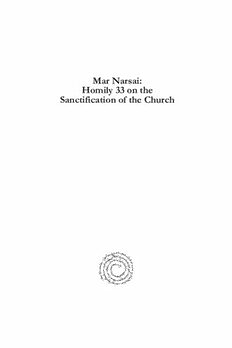
Mar Narsai: Homily 33 on the Sanctification of the Church PDF
69 Pages·2018·0.457 MB·English
Most books are stored in the elastic cloud where traffic is expensive. For this reason, we have a limit on daily download.
Preview Mar Narsai: Homily 33 on the Sanctification of the Church
Description:
Narsai, called the "Lyre of the Holy Spirit," on account of countless metrical memre-hymns that he composed, lived between ca. 399 and ca. 502, and was thus contemporary for a while of another major theologian and poet, Jacob of Sarug (d. 520). Narsai's memra 33, according to Mingana's classification, is made of 12 by 12 syllables, and its title "On the Sanctification of the Church" suggests that it was written for the feast of the Dedication of the Church celebrated by the Church of the East to this day on the first of November. The memra names the Church of the Nations the Bride of the Bridegroom Christ, a concept found in Colossians 11 and ultimately in Hosea 2, where the relationship between God and his people is expressed in terms of the wedding. The memra comments at length how the Church was saved by the Cross and was nurtured by the Eucharist, out of Christ's love for her. Interestingly, Narsai associates the Church with the faithful in that both are sanctified by the same sacraments and thus the Church in the memra is personified. Narsai's style, way of thinking, and terminology used to refer to the rāzē-mysteries correspond to what we find in the writing of Ephrem the Syrian and Jacob of Sarug. Not surprisingly, the memra's expressions, concept, and even verses found their way in the liturgical books of the Church of the East, especially in the prayers devoted to the Dedication of the Church.
See more
The list of books you might like
Most books are stored in the elastic cloud where traffic is expensive. For this reason, we have a limit on daily download.
